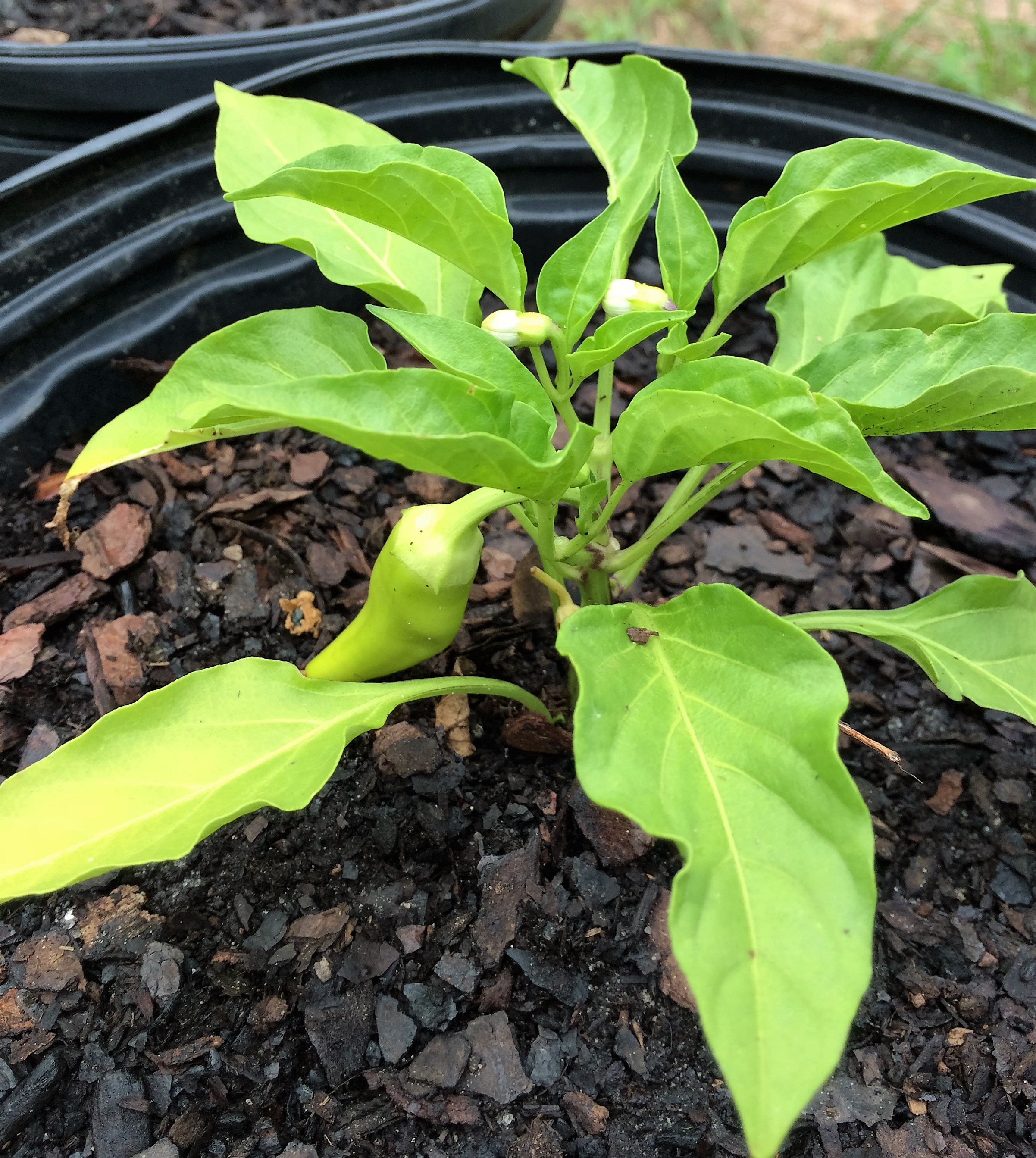
by Matt Lollar | Oct 14, 2021
There seems to be a lot of interest in being sustainable and saving seeds is one way to be food sustainable. Should you save seeds from your garden? When it comes to peppers and a number of other vegetables in your garden…it depends.
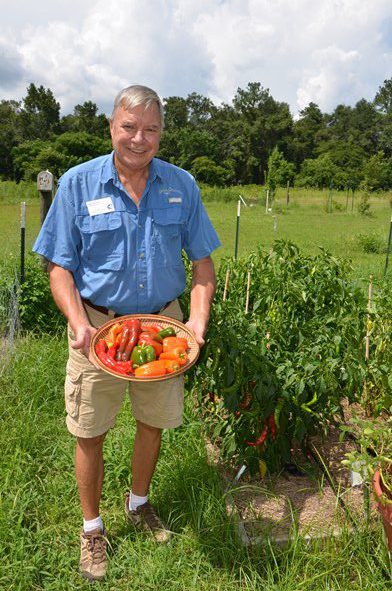
Wakulla Master Gardener Bill Osborne shows off some of the peppers he grew.
Hybrid vs. Open-pollinated
If you plan to save seed from your peppers, you first need to determine whether you planted open pollinated or hybrid peppers. Hybrid varieties are produced from two distinct pepper varieties and are often designated by “F1” appearing after the variety name. The seed from hybrid varieties is not usually saved because it does not produce plants and fruit that are true to the original variety. Open-pollinated varieties are developed from inbreeding plants for multiple generations to develop a stable genetic make-up. Seeds saved from these varieties will produce plants and fruit that are true to type.
How to Save Seed
To save seed of a known variety, it is important to isolate flowers or plants to ensure cross pollination from other varieties does not occur. There are four common ways to isolate flower/plants.
- Isolate plants from pollinizer insects by growing them indoors or in a greenhouse.
- Cover individual plants with insect exclusion netting.
- Separate different varieties by at least 400 feet.
- Put a small bag over an emerging flower until it has self-pollinated. Then remove the bag for fruit development.
The options above will help ensure your plants produce seed true to type. A fun experiment would be to save seed from plants/fruit that are not isolated and planted near other pepper varieties. There are endless possibilities on the peppers your new varieties would produce and you may end up developing your own named cultivar. You could also choose one of the isolation techniques listed to selectively cross different pepper plants. One misconception about growing peppers is that hot peppers planted near sweet peppers will influence the flavor of the sweet peppers. As you may have gathered from the information about crossing varieties, the flavor of the next generation will be influenced by hot and sweet pepper being allowed to cross pollinate.
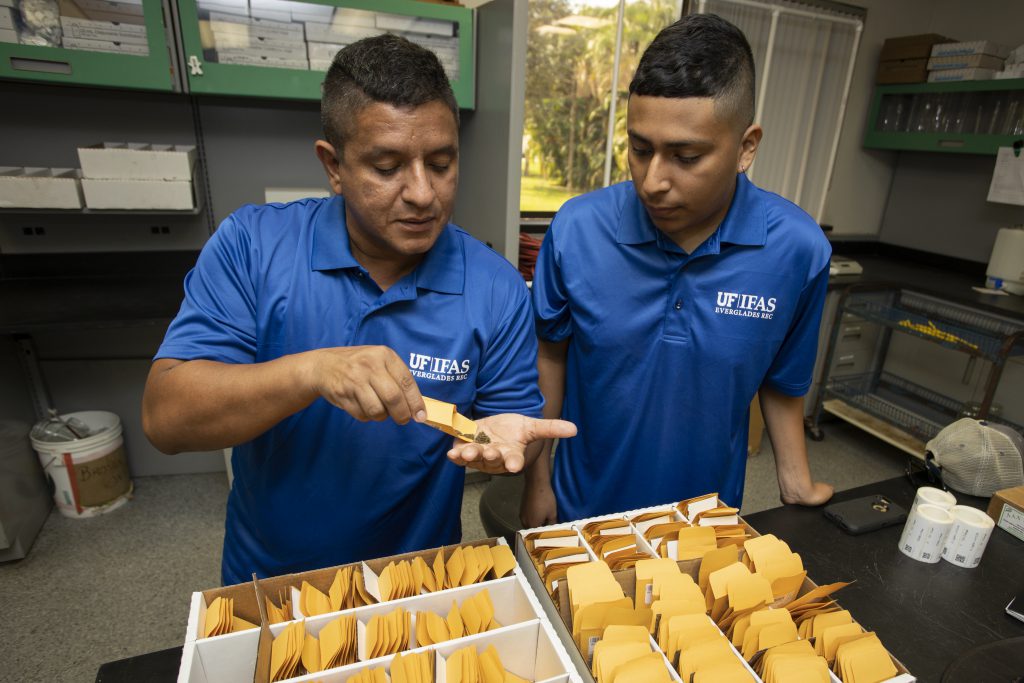
German Sandoya (left) examining seed samples in a lab at the Everglades Research and Education Center. Photo University of Florida/IFAS
Harvesting and Processing Seed
Peppers should be allowed to mature before seed is harvested. In fact, germination rates are higher when peppers are allowed to dry for at least one month before seeds are harvested. Make sure that no mold or disease is on the peppers, because this could affect germination rates. To harvest the seeds, simply remove them from the pepper and remove any flesh from the pepper. If the seed was harvested from fresh peppers, rinse the seed thoroughly and allow to dry before placing in a sealable bag or container. If the peppers were allowed to dry before seed harvest, then the rinse step can probably be skipped. Store the seed in a cool, dark, and dry location such as a refrigerator.
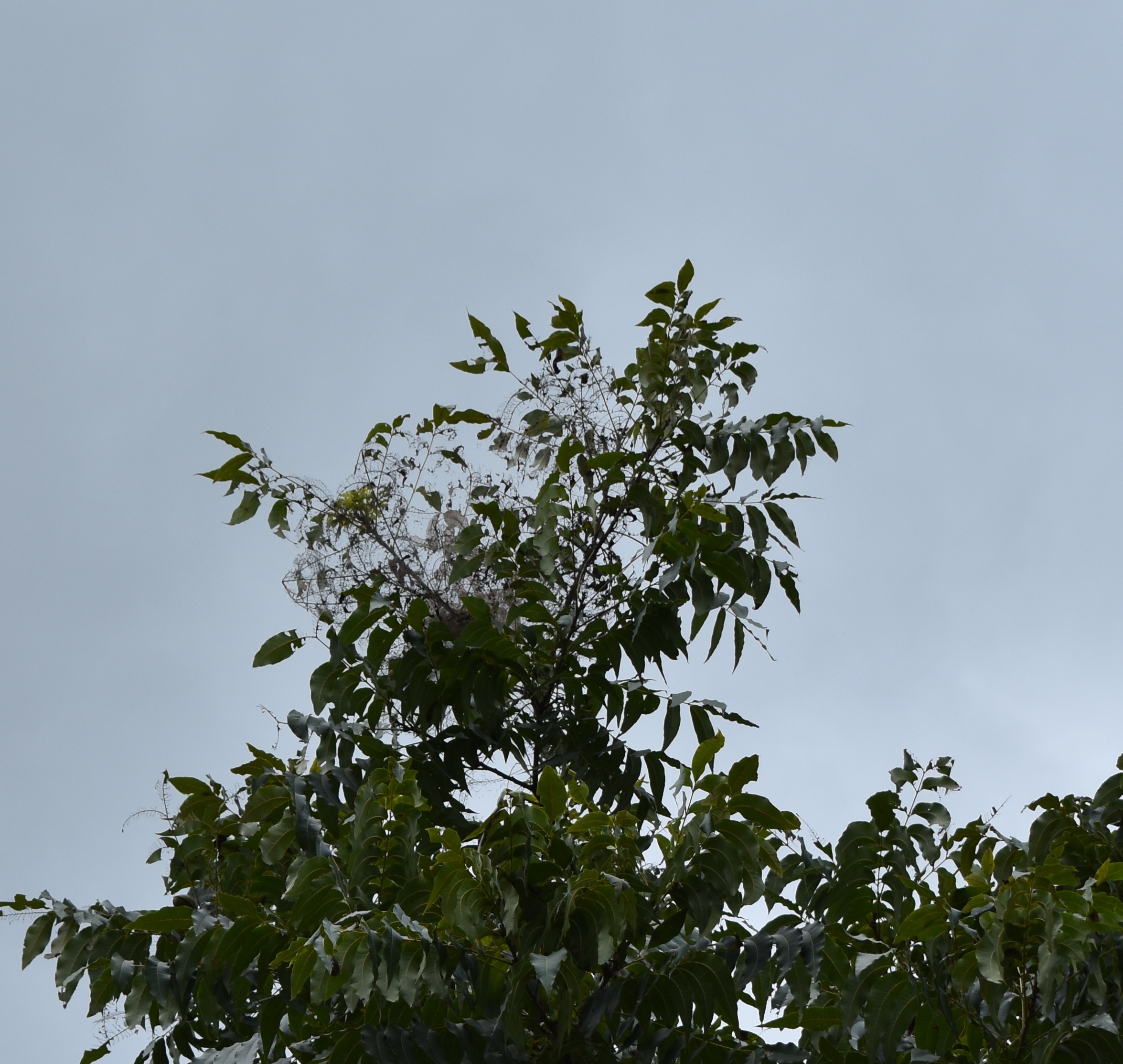
by Matthew Orwat | Sep 13, 2018
Bare limb tips and clusters of webbing in pecan trees are often the first sign that fall is right around the corner.
This webbing is caused by clusters of the larvae of the Fall Webworm (Hyphantria cunea (Drury)) which is often also called Pecan Webworm. “Fall Webworm” is a bit of a misnomer in our region since they are able to strike in spring and summer thanks to our long growing season. They are most noticeable in the fall thanks to cumulative effects of earlier feeding.
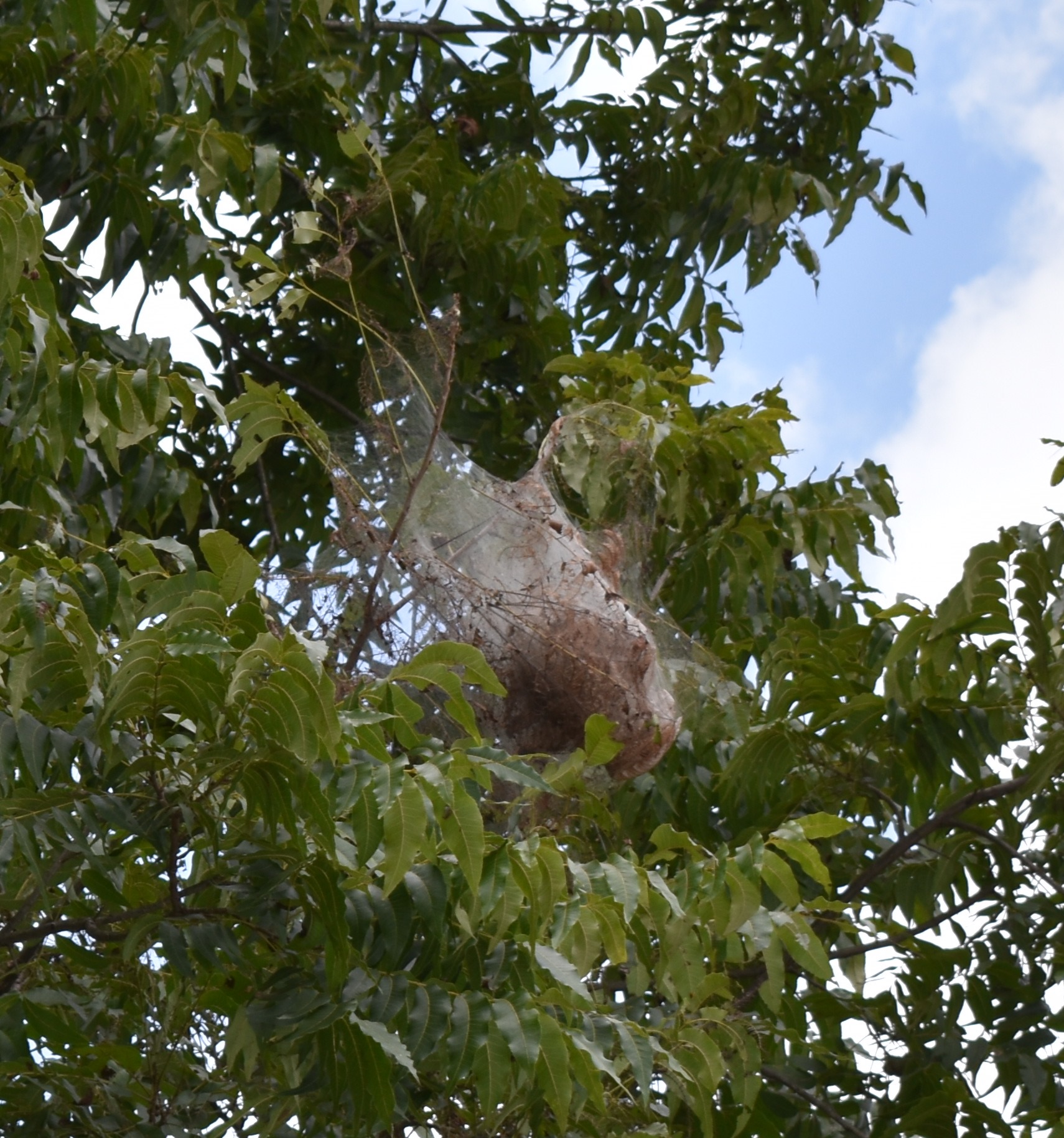
The adult form of the fall webworm is a solid white or white and brown spotted moth that emerges in late March through August in southern climates. After mating they lay orderly clusters of green eggs, usually May through August. Soon after emergence, the larvae begin creating silk webs to protect themselves as they voraciously feed on their various host plants, of which Pecan is most common in Northwest Florida gardens.
Although they are capable of defoliating complete trees, especially smaller ones, most seasons they are kept in check by beneficial insects such as the paper wasp. It is beneficial for small orchards or home growers to scout their trees from June through August. If small webs are observed in young trees, it is best to prune them out with a pole saw or pole pruner and dispose of the branch. Pruning of small branches does not harm the tree, but it may be of no benefit to remove small webs in larger trees, if they are being controlled by natural enemies.
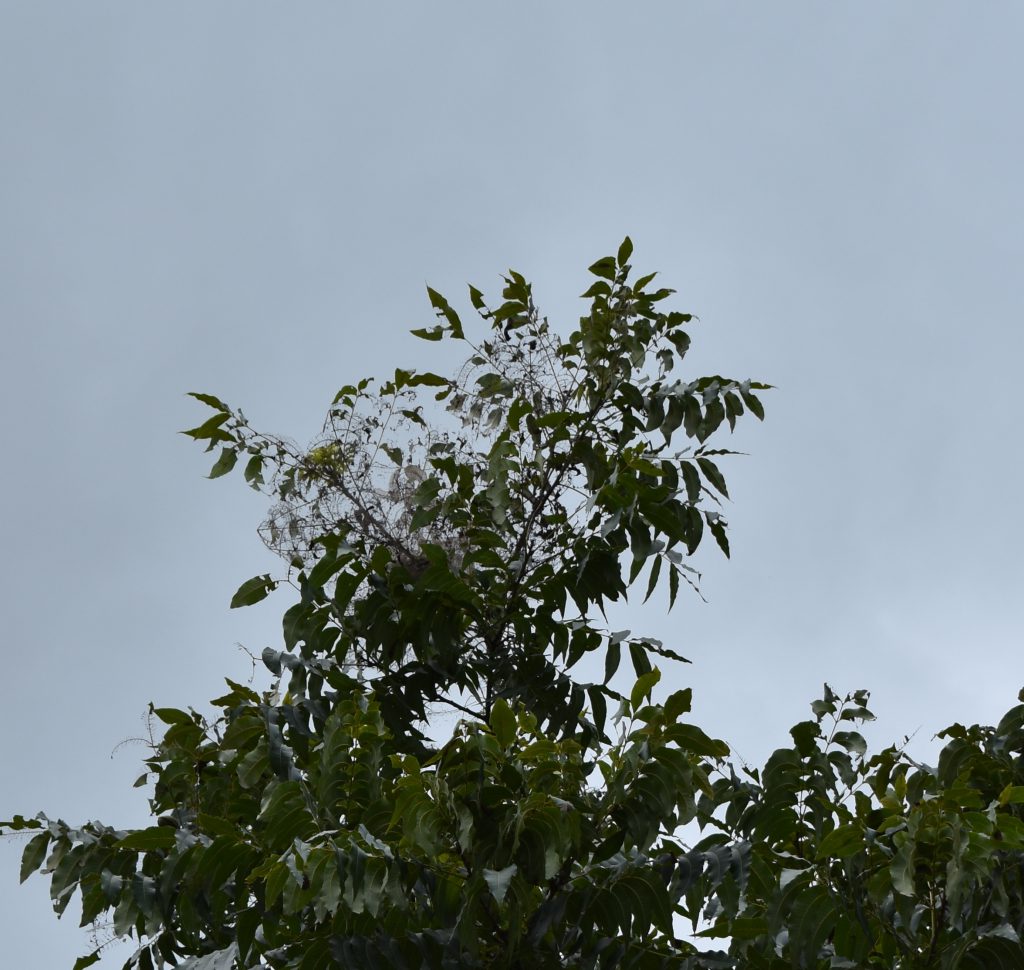 Most home gardens don’t have a practical ability to spray for this insect. For homeowners it is difficult to spray for control, due to the cost of the equipment required to get the spray into the tree canopy. If spraying is an option, many insecticides containing spinosad or Bacillus thuringiensis (Bt) exist. Both of these products target caterpillars while not harming beneficial insect predators that feed on these worm populations. Several more toxic insecticide products exist that will control fall webworm, but they often exacerbate insect problems by killing off beneficial insects that might be controlling other insect pests.
Most home gardens don’t have a practical ability to spray for this insect. For homeowners it is difficult to spray for control, due to the cost of the equipment required to get the spray into the tree canopy. If spraying is an option, many insecticides containing spinosad or Bacillus thuringiensis (Bt) exist. Both of these products target caterpillars while not harming beneficial insect predators that feed on these worm populations. Several more toxic insecticide products exist that will control fall webworm, but they often exacerbate insect problems by killing off beneficial insects that might be controlling other insect pests.
Fall webworm is not usually a serious problem for home gardens. Let natural enemies take care of the problem in most cases.
Supplemental Material:
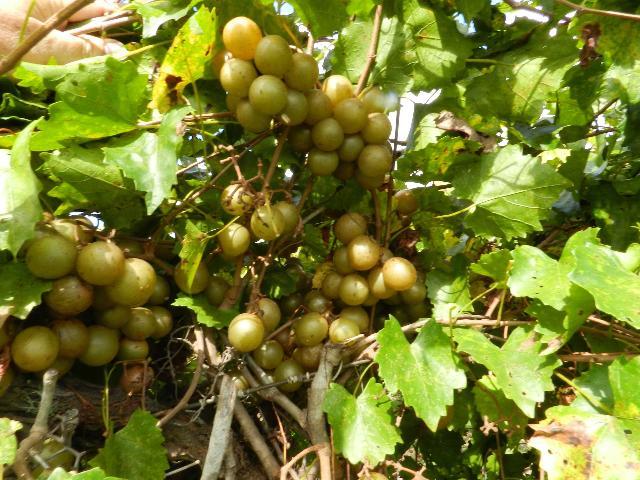
by Matthew Orwat | Aug 3, 2015

Muscadine cluster Credit: Peter C. Andersen, UF/IFAS Extension
Muscadines are a terrific grapey treat this time of year ’till fall throughout North Florida. To grow muscadines well in the home garden, care must be taken when pruning to maximize spatial efficiency and yield.
August is the very beginning of the muscadine harvest in the Florida Panhandle, which may last until October. Therefore it is also the time to begin thinking about pruning.
Once harvest concludes, it is usually a gardeners’ natural inclination to immediately prune their muscadine vines. This fast action is not the best for plant condition and next year’s yield, especially if there is an early frost. Early frosts surprise the plant before sugars have been moved to the roots for storage during dormancy. Therefore, waiting to prune in mid January to mid March will ensure that the vine has had adequate time to go dormant and acclimate to the winter season. A good rule of thumb is to wait to prune until bud swell or even first leaves emerge. This will greatly reduce the chance that vines are damaged by late frosts.
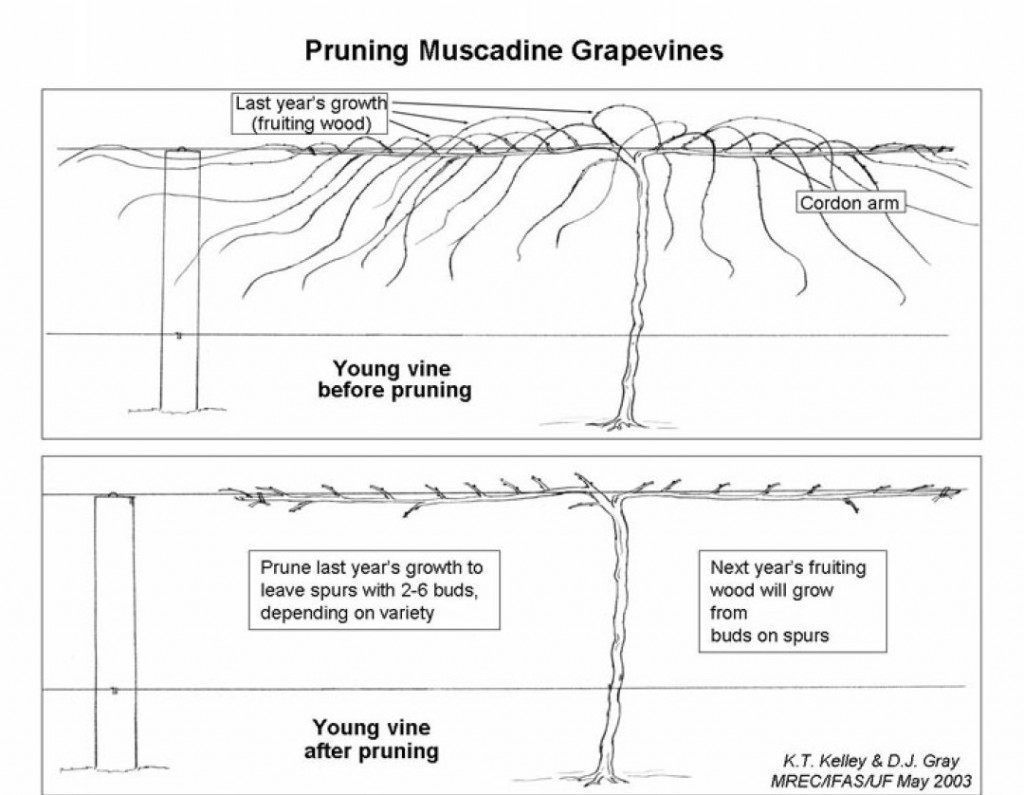
K.T. Kelly and JH. D. Gray, MREC/ UF/IFAS Extension 2003
Muscadines flower and fruit on shoots from current, not previous, years growth. These new bearing shoots arise from the leaf axils of the previous years’ growth. Pictured above is the bi-lateral cordon training system. This is the most popular system for muscadine production. Pruning must be performed to maintain this configuration. If vines are too vigorous, it is acceptable to prune lightly throughout the growing season.
Vines must also be trimmed before herbicide application at least 2 feet from the ground. Nonselective systemic herbicides don’t harm tissue with bark, but must not come in contact with green tissue or it will be translocated to the roots and damage the plant.
Using a bi-lateral cordon system, there are two main branches or “cordons” of the vine. Along each cordon, fruiting spurs should be spaced approximately every six inches. Each fruiting spur should contain 2-4 nodes.
If fruiting spurs become more than one foot from the cordon, it is time for spur renewal. This is typically done every 3-6 years. Entire spurs can be removed if they lose productivity and replaced by new shoots. Additionally, cordons may lose productivity or die off after 5 to 10 years of production. If this occurs, simply remove the cordon and train a new or existing branch into a new cordon.
Pruning with a design in mind and at the proper time will enhance performance and longevity of muscadines in the home garden.
Information from this article was derived from HS763 The Muscadine Grape

by Matthew Orwat | May 19, 2015
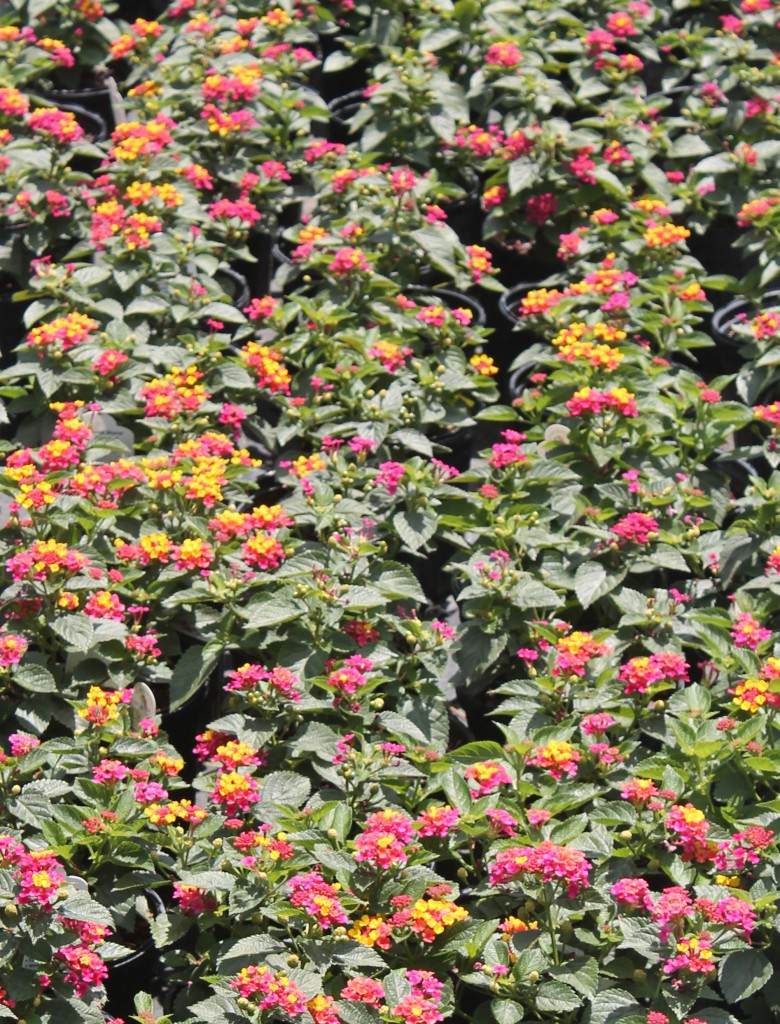
Dwarf lantana – Image UF IFAS Extension, Matthew Orwat
With the heat of summer already here, we all know that our pansies, petunias and snapdragons are on their way out. This leaves us wondering what we could plant that will give us color throughout summer and fall to the first frost.
Many are weary of Lantana camara, the common garden lantana, because of its potential as an invasive species and large rampant size. Good news, there are several dwarf cultivars that have no invasive potential because they are sterile. Additionally, many other dwarf cultivars grow slow and produce few seed, so they have low invasive potential.
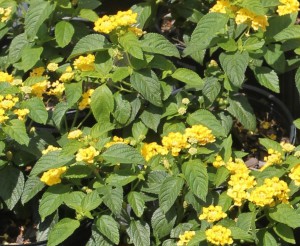
Dwarf lantana. Image credit UF/IFAS, Matthew Orwat
Northwest Florida is not in the natural range of the endangered South Florida native Lantana depressa, so the outcrossing danger does not exist in our area.
Dwarf lantanas are available in either mounding or trailing types. Mounding types rarely get over 1 foot tall and have an equal spread while trailing lantanas stay lower to the ground but can spread several feet. They are available in several colors including yellow, purple, white, multicolor and red. They provide reliable color in flushes from late spring until first frost
When mature, dwarf lantana are drought tolerant but need supplemental watering to get established. They also thrive in poor soils and need little fertilization.
Dwarf lantana usually acts as a perennial, but die to the roots during extremely cold winters.
Lantanas that are known to be relatively non-invasive include Patriot, Hallelujah, Sunburst, and Cowboy. Florida Exotic Pest Plant Council recognizes the cultivars ‘Gold Mound’, ‘New Gold’, ‘Alba’ and ‘Patriot’ as cultivars that are not known to produce viable seeds. Other newer dwarf varieties need to be evaluated on a case by case basis, but varieties the author has observed as no to low seed set in the landscape. Also if home gardeners are worried about seed production, spent blooms can be pinched off so no seed can form. This pinching off practice also speeds up re-bloom and is thus highly encouraged.
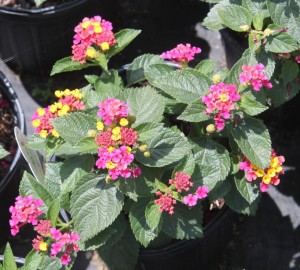
Dwarf lantana – Matthew Orwat, UF/IFAS
by Taylor Vandiver | Oct 7, 2014
I think it’s safe to say fall is officially here. Shouts can be heard from local football stadiums, occasionally a crisp fall breeze will send us looking for a light jacket, and coffee shops are pushing all things pumpkin. Now that we can officially appreciate the cooler fall weather, it may be time to stretch our legs and marvel at the spectacular show of color our landscapes are putting on. Here are a few plants that are showing off this time of year.
Firebush (Hamelia patens) – This charming Florida native will delight everyone with beautiful orange-red flowers throughout most of the year. Hummingbirds and butterflies enjoy the nectar in the flowers. Firebush can reach a height and width of 8 to 12 feet. It is a fast growing plant that will grow well in part to full sun environments.
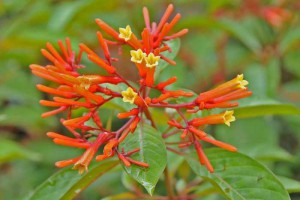
Bright orange-red blooms on a firebush. Photo courtesy UF/IFAS.
Salvia (Salvia spp.) – Salvias are great plants for bringing butterflies and hummingbirds to your garden and as a bonus, they have no serious pests. With hundreds of annual and perennial species coming in an array of colors and sizes, you can easily find one or more to complement your landscape. Salvias perform best in full sun environments and are considered drought tolerant.
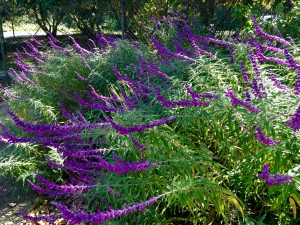
Deep purple blooms on a salvia in the landscape. Photo courtesy Taylor Vandiver.
Turk’s Cap (Malvaviscus arboreus) – Turk’s cap can add a cheerful pop of color at a time when little else is blooming. This old-fashioned Florida-Friendly shrub like perennial is related to the hibiscus. It’s known for its bright red flowers that always seem ready to open, but never do. Turk’s cap starts blooming in summer and keeps going until through winter, unless hit by a hard frost. It can grow in full sun and reach up to ten feet tall and ten feet wide, so give it room to grow. This easy-care native perennial requires little maintenance once it’s established.
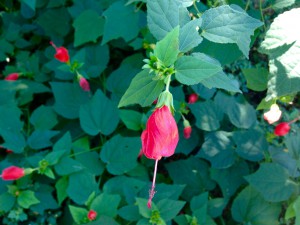
Turk’s cap showing off its unique blooms. Photo courtesy Taylor Vandiver
Coleus (Solenostemon scutellarioides) – When imagining fall color we often don’t consider coleus. However, the vibrant foliage can add interest to any landscape throughout the fall. Coleus is prized for its colorful foliage, which comes in shades of green, yellow, pink, red, and maroon. Coleus varieties can range from one to several feet in height. They can be used in hanging baskets, containers on patios, or in landscape beds. Coleus prefers partial shade and you can pinch the growing stems of young plants frequently to encourage dense foliage. Keep an eye out for mealybugs on coleus and use insecticidal soap if problems develop
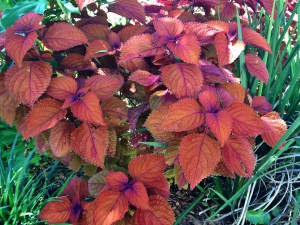
Burnt orange foliage standing out amongst the neutral green of the landscape. Photo courtesy Taylor Vandiver.
Fore more information contact your local extension agent. Also you can visit us at gardeningsolutions.ifas.ufl.edu or edis.ifas.ufl.edu.
















